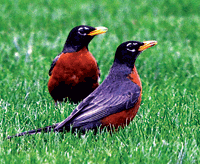THE MUSIC OF BIRDS
 My sister found it in a used bookstore in Augusta, Georgia, bought it and gave it to me. It’s obviously very old. Its cover is dull and splotchy, the title, Field Book of Wild Birds, is faded and hard to read. It’s the size, the height and width, of Roger Tory Peterson’s Field Guide to the Birds, though it’s thicker. It’s a book that a birder could take in the field, carrying it in a pocket, a large pocket. I assumed Field Book of Wild Birds was a book about bird identification.
My sister found it in a used bookstore in Augusta, Georgia, bought it and gave it to me. It’s obviously very old. Its cover is dull and splotchy, the title, Field Book of Wild Birds, is faded and hard to read. It’s the size, the height and width, of Roger Tory Peterson’s Field Guide to the Birds, though it’s thicker. It’s a book that a birder could take in the field, carrying it in a pocket, a large pocket. I assumed Field Book of Wild Birds was a book about bird identification.
Opening it I found this was a second edition, published in 1921, the first edition was published in 1904. A Field Guide to the Birds by Peterson was first published in 1934. Here was a book about birds published thirty years before Peterson’s famous Field Guide.
This, however, was not a field guide for identification. Inside I found the full title was Field Book of Wild Birds and Their Music. The introduction is titled An Introduction to Bird Music. Following the introduction is A Musical Key which describes putting birds’ songs on a musical scale and distinguishing notes, differences in rhythm and in time. Following that is a glossary of musical terms, most of them terms I do not know, adagio, cadenza, diatonic scale, forte and many more.
I’m familiar with recognizing birds by their songs or calls. Every bird watcher is. Often I hear and name a bird before I see it. I spot some birds, particularly little birds that feed and nest among the leaves, because I hear them and look for them.
Everybody must recognize the call of the killdeer, a blue jay, a Canada goose. Nearly everybody recognizes the song of a robin, the cooing of a mourning dove. Peterson described the song of each bird in his Field Guide, even the 1st edition which I have, and each subsequent edition. Peterson’s description of the robin’s song is two lines of print.
In the big bird book, Birds of America, the robin’s song is described as a cheerful warble composed of ascending and descending notes. Other authors use other words, often words representing the notes, frequently cheer-up cheer-up cheer-up. In one book I have the robin’s song is described as cheerily, cheer up, cheer up, cheerily.
In Field Book of Birds and Their Music the description of the robin’s song is four and a half pages. It includes an analysis of tone and rhythm plus several pictures of musical scales with notes.
Peterson’s description of the call of the eastern meadowlark, another bird with a well-known song, is three lines, that of the western meadowlark two lines. In Bird Music the description of the song of the meadowlark, with no distinction between eastern and western, is five pages.
Roger Tory Peterson’s Field Guide to the Birds with pictures, similar species pictured together, brief descriptions, distinctive colors and marks emphasized, highlighted by small black marks in the pictures, is credited with making bird identification simple. It’s credited with having a large part in making bird watching the popular activity that it is today, more popular in number of people participating than hunting and fishing together.
Field Book of Wild Birds and Their Music was never a popular book I’m certain. I have many books about birds including Birds of America in the original edition, three volumes, published in 1917. I have the later single volume edition published in 1936. I have all four editions of Peterson’s Field Guide to the Birds. But I never saw nor read of A Field Book of Wild Birds and Their Music until my sister gave me the copy she found in a used bookstore in Augusta, Georgia. Interestingly, inside the front cover it’s stamped “Pontiac Branch, Public Library, Fort Wayne and Allen Co., Ind.”
- Birds As Weather Forecasters – Life In The Outdoors - December 17, 2021
- Rare Bird Spotted In Indiana – Life In The Outdoors - October 8, 2021
- MY EXPERIENCE WITH DEER – Life In The Outdoors - July 30, 2021


